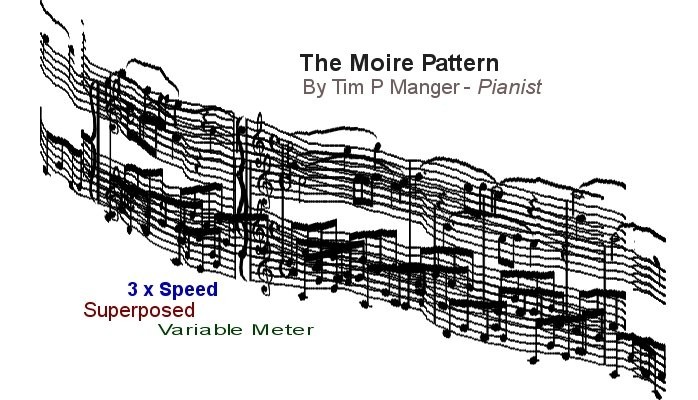
The Moire Pattern – The 4th Dimension of Musical Exploration
As one develops as a pianist, there is always a natural ‘pull’, drawing one closer to a predetermined point (some liken it to a musical ‘black hole’). For some pianists it is a specific composer, for others it is a specific genre.
For me, it has taken half a lifetime of playing and performing, to finally understand that my great passion lies somewhere between 'Improvisation' and 'Experimentation' (it could be argued that the two are not mutually exclusive). In previous articles I have written about my influences and influencers, and once again I can’t help but iterate my all-time favourites; Cage, Satie and Schoenberg (among others), for their incredible pioneering into music and sound.
My personal explorations have lead me down some amazing musical pathways, and I have recently revisited my enormous interest in ‘The Moire Pattern’.
So what is it, and where did it come from?
Put simply, the ‘Moire Pattern’ is a mathematical concept, best depicted in graphical terms. To understand it, have a look at the graphic below.
You will notice that there are 2 identical patterns placed over one another, slightly offset. The end result is a completely unexpected and new subset of images that emerge, overriding the underlying simple structures that lay beneath.
So Where does the Moire Pattern appear in Music
Like many pianists, I first came across the ‘Moire Pattern’ when studying Chopin’s Fantaisie Impromtu in C#minor (Op.66). At first I viewed the 'Impromtu' as a fairly straight forward ‘cut common’ time but then (upon closer inspection), I realised that there was something quite disturbing and beautiful about the work.
The left hand plays a pulse in a triple meter, where as the right hand plays a pulse in a duple meter. Played ‘straight’, this piece sounds ‘brilliant’ however, played ‘superposed’, this piece sounds simply ‘breathtakingly magical’.
That’s right…this piece does not just require you to set your metronome on ‘x'-bpm’, moreover it requires some serious thought and preparation. It may be worth pointing out that the ‘Moire Pattern’ is only 'partially complete' at the point when the notation has been mastered.
The ‘Real Magic’ happens (only) when the speed of the hands is altered slightly. That’s right…not only is Chopin suggesting a varying meter in both hands, but also varying tempi. The other anomaly lies in the question; 'which meter and what tempo?'
The answer to the riddle lies in the moment, when the music suddenly (when superposed with varying meter and time), gives the impression that the piece has strangely catapulted to 3 times it's actual speed.
It may be worth noting that there is a tempo range at which this will occur, and despite the piece being marked ‘Allegro Agitato’, it really doesn’t give much away. When setting the metronome, one must factor in the ‘cut common’ element (as well as the 'Agitato' element), which is better thought of as 2/2.
The Moire Effect on the Pianist & Audience
When I first played through the various iterations of the Chopin Op.66, I was struck with emotion when I finally hit the apex of the ‘Moire Curve’ (achieving perfect meter, pulse and tempo simultaneously).
In addition, there was a moment of enlightenment, where I became overwhelmed by the fact that there seemed to be more notes coming out of the piano, than were actually being played. It was one of the most humbling experiences of my piano journey.
In a recent set of piano recordings, I have attempted to recreate the ‘Moire Pattern’, using Impressionist style Improvisations utilising a similar concept to the Chopin Op.66. What I have found is that there is a ‘Worm Hole’ in music...access to another dimension in musical understanding and experience.
Whilst it sounds completely crazy, I believe there is actually a fourth dimension in music, and it’s gateway lies at the foothills of the daring and adventurous. I will be writing more about the 'Moire Pattern' in future articles, as well as discussing it in my new book 'Modal Diametry'.
Written by Tim P Manger
Pianist | Composer | Author

